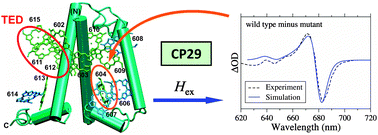Towards a structure-based exciton Hamiltonian for the CP29 antenna of photosystem II†
Abstract
The exciton Hamiltonian pertaining to the first excited states of chlorophyll (Chl) a and b pigments in the minor light-harvesting complex CP29 of plant photosystem II is determined based on the recent crystal structure at 2.8 Å resolution applying a combined quantum chemical/electrostatic approach as used earlier for the major light-harvesting complex LHCII. Two electrostatic methods for the calculation of the local transition energies (site energies), referred to as the Poisson–Boltzmann/quantum chemical (PBQC) and charge density coupling (CDC) method, which differ in the way the polarizable environment of the pigments is described, are compared and found to yield comparable results, when tested against fits of measured optical spectra (linear absorption, linear dichroism, circular dichroism, and fluorescence). The crystal structure shows a Chl a/b ratio of 2.25, whereas a ratio between 2.25 and 3.0 can be estimated from the simulation of experimental spectra. Thus, it is possible that up to one Chl b is lost in CP29 samples. The lowest site energy is found to be located at Chl a604 close to neoxanthin. This assignment is confirmed by the simulation of wild-type-minus-mutant difference spectra of reconstituted CP29, where a tyrosine residue next to Chl a604 is modified in the mutant. Nonetheless, the terminal emitter domain (TED), i.e. the pigments contributing mostly to the lowest exciton state, is found at the Chl a611–a612–a615 trimer due to strong excitonic coupling between these pigments, with the largest contributions from Chls a611 and a612. A major difference between CP29 and LHCII is that Chl a610 is not the energy sink in CP29, which is presumably to a large extent due to the replacement of a lysine residue with alanine close to the TED.

- This article is part of the themed collection: Photosynthesis: From Natural to Artificial

 Please wait while we load your content...
Please wait while we load your content...